
Credit: Paul C. Focazio / NYSG
New York, NY, May 10, 2017 - The 2017 Waterfront Conference sets sail with a day of dialogue about New York and New Jersey's shared harbor featuring City of New York Mayor Bill de Blasio, City of Newark Mayor Ras J. Baraka, Rep. Nydia M. Velázquez and hundreds of others.
In addition to commemorating host The Waterfront Alliance’s 10th anniversary, this year’s conference marks another year-in-the-making milestone, as President and CEO Roland Lewis explains: "We're celebrating the very recent launch of NYC Ferry. Our blue highways are now connecting the Rockaways in Queens and Sunset Park in Brooklyn to lower Manhattan for the same cost of a subway ride, with more routes rolling out this summer and next year. Hundreds of thousands of New Yorkers in transit starved neighborhoods now have a fast, convenient, and affordable way to connect to all the opportunities our City has to offer. We call this victory."
Following this year's keynote address, there will be a plenary session about how changes in Washington, D.C. will undoubtedly affect our waterfronts — "What Now? Navigating uncertain waters ahead for our waterfronts" — and previewing our region’s first scorecard measuring indicators of waterfront access, water quality, and coastal resiliency — "Get Wet When You Want, Stay Dry When You Need: A scorecard for strong, healthy, and open waterfronts."
A primary question threaded in the day's discussions, which can be tracked on Twitter via the hashtag #WaterfrontConference, will be: How do we assess the countless ways our harbor and waterfronts provide value to our region - from educational opportunities to good-paying jobs to public recreation to waterborne transit?
For the second year, The Waterfront Alliance welcomes its Arcadis Waterfront Scholars, a program that brings together aspiring waterfront stewards for a day of learning and networking on the water. In 2017, there are 70 undergraduate and graduate students aboard who represent nearly two dozen academic institutions and nearly as many disciplines. This brings the total number of scholars to 170 in the past two years.
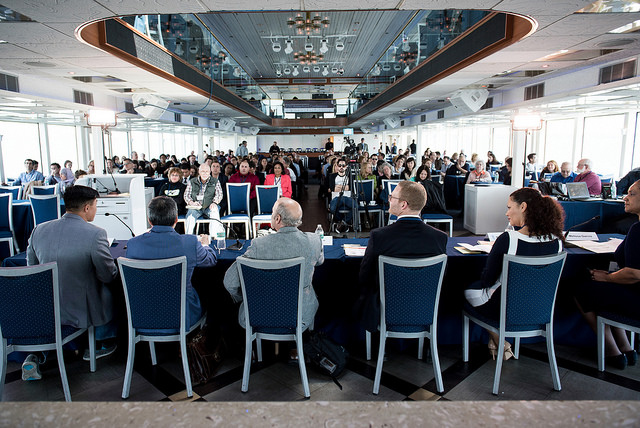
"Forgotten Waterfronts: Activating and Engaging the Shoreline" was one of the multitude of panels served up at mid-May 2016's Annual Waterfront Conference. The conference provided a platform for participants to debate the future of our region’s waterfronts, tackling the challenges to defining and delivering equitable access to jobs, education, transportation, and recreation at the water’s edge. Credit: Waterfront Alliance
Last May, more than 500 people boarded the Hornblower Infinity for the 2016 Waterfront Conference, where the overarching subject matter was "defining and delivering equity at the waterfront."
The conference began with a “keynote conversation” between Maria Torres-Springer, president of the New York City Economic Development Corporation (NYCEDC), and Professor Michael Sorkin.
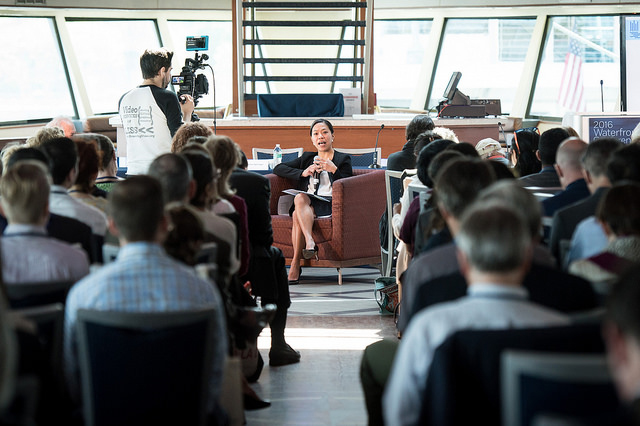
Keynote speaker Maria Torres-Springer, NYCEDC President and CEO. Credit: Ian Douglas / Waterfront Alliance
"What I find to be exciting is the fact that so many people today are interested and have great ideas about the question of what it means to deliver equity on the waterfront," said Torres-Springer. "Everyone appreciates that while there has been extraordinary transformation of our waterfront in the last generation, there are still a lot of questions we have to answer about what are our goals — not just for the waterfront but the waterways and the water itself. What are the types of uses that have to be balanced? Is the waterfront a place of commerce and industry, or is it a place to play — or all of that? And who decides? Those are all profound questions that we have to continue to tackle together as a city in order to have not just a thriving waterfront but a shared waterfront."
The event proceeded with interactive panel discussions, with topics ranging from financing and management of public waterfronts to the best ways to bring urban youth to the water.
The NYCEDC's new Waterfront Navigator Web site — a one-stop shop for waterfront planners providing advice on what goes into successful drawings, plans, and photos required for applications — was launched on board. Afterwards, the boat pulled away from the dock for a working-waterfront-themed cruise to the Kill van Kull, a tidal strait between Staten Island, New York and Bayonne, New Jersey.
Numerous conference-goers, including the ones cited here, shared their thoughts during the day on what the conference has meant to them over the years:
“I’m very excited about the potential collaborations that are in store for me in terms of the people I met today.” – Anna Lisa Jensen, Brooklyn-based artist who is trying to activate a waterfront lot in Bay Ridge
“It was interesting to see people from the perspective of real estate, from the perspective of community, from the perspective of waterfront access, and from the perspective of water quality.” – Mai Armstrong, photojournalist
“I’m excited that there are this many people that are as passionate about the waterfront as I am.” – Colin Powers, paddler and surfer
“It’s great to be surrounded by people who are thinking constructively about the waterfront.” – Kaitlin Petersen, president of Manhattan Community Boathouse
“I thought it was a great opportunity to network and connect with people.” – Olivia Owrebell, National Parks Conservation Association
“It was a great event celebrating the water and everyone who hopes to make positive contributions to it.” – Ahmed Ismail, The Port Authority of New York & New Jersey
“I’m thinking it’s cool to be surrounded by so many people with great ideas about the waterfront. On the boat ride, you could look out and see varied the waterfront is.” – Paola Valenti, student at New York University
“The waterways are a vast resource, and they’re underutilized. To me, it’s fascinating how you are raising a certain awareness among the youth—and this is really important for the future of the waterfront.” – Rico Blando, international student at Fordham University
For more on The Waterfront Alliance's Annual Waterfront Conference, visit waterfrontalliance.org/what-we-do/waterfront-conference.
Sea Grant's NYC Connection
The Waterfront Alliance is a coalition of some 950+ organizations — which includes New York Sea Grant — that work together to bring about real change to our region’s 700 miles of shoreline.
Here are some of Sea Grant's recent efforts in and around New York City:
Making Climate Forums Available to New York City Residents
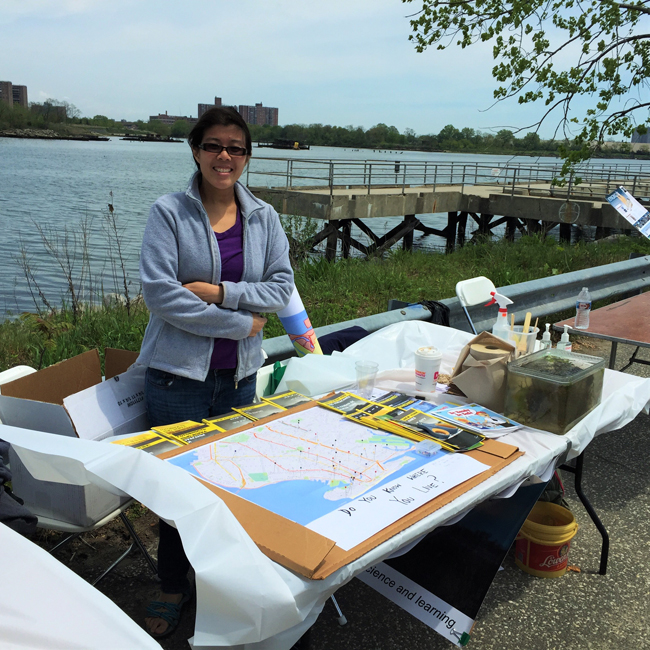
A new monthly podcast and a climate forum series (the next one of which, "Beat The Heat," is being held in Far Rockaway, NY on Wednesday, May 24th) are just two of the offerings served up by Sea Grant and partner The Science and Resilience Institute @ Jamaica Bay (SRIJB).
In February 2016, a formal announcement of the partnership was made with the hiring of a Jamaica Bay Coastal Resilience Specialist, who, along with SRIJB, is located at Brooklyn College.
For more on these and other initiatives, visit www.nyseagrant.org/jamaicabay and www.srijb.org.
Hudson River Projects: Estuary Climate Change Lesson Plans; Waterfront Accessibility to People with Disabilities; Visualizing Coastal Change Over Time
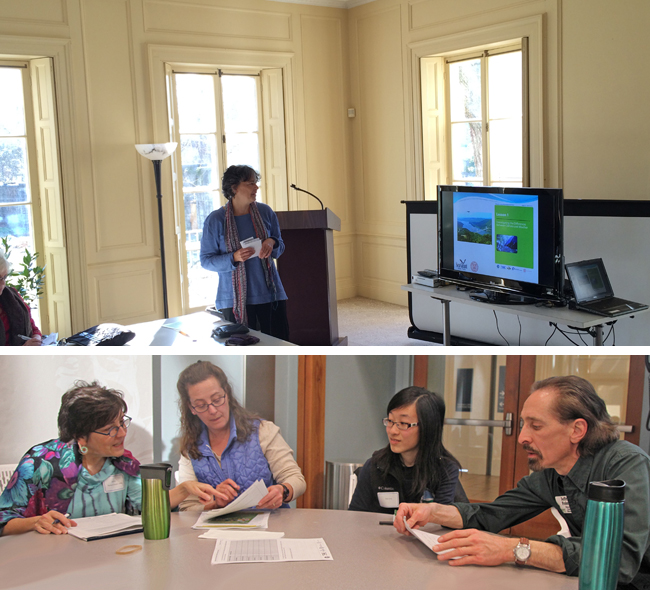
"Understanding the relationship between weather and climate are
important first steps to understanding larger-scale global climate
change," says NYSG Hudson Estuary Specialist Nordica Holochuck, who
tested this and other lesson plan concepts with educators during a
mid-November workshop on climate change and its impacts.
Holochuck has
been working with partners from Cornell University and the New York
State Department of Environmental Conservation's Hudson
River Estuary Program on this new series of teaching curricula designed
to help middle school students understand climate and
weather basics and explore climate change-related issues close to home
in the Hudson River Valley.
The teaching curricula fit into Learning
Standards for New York State, Next Generation Learning Standards and the
Common Core.
For more, visit www.nyseagrant.org/hvclimate; Also see a related fact sheet summarizing the effort (pdf).
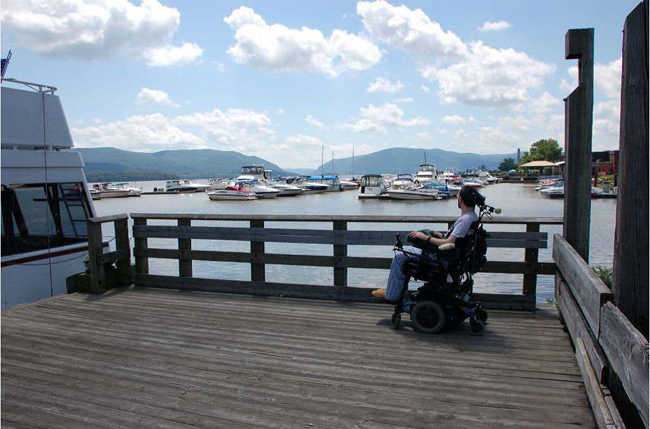
An Independent Living Center Assessment Team Member enjoys the Newburgh waterfront. Credit: Cornell University Northeast Americans with Disabilities Act Center.
Beginning in 2013, to increase recreational access to New York’s waterfront resources for people with disabilities, New York Sea Grant partnered with the Northeast Americans with Disabilities Act Center (NADAC) at Cornell University to develop and deliver an assessment of 18 boat launches and adjacent beach areas located along 100 miles of shoreline on both sides of the Hudson River.
For more, see "Partnership Puts Accessibility for All at Boat Launches and Waterfront Parks Within Reach," as well as a related fact sheet that summarizes the effort (pdf).
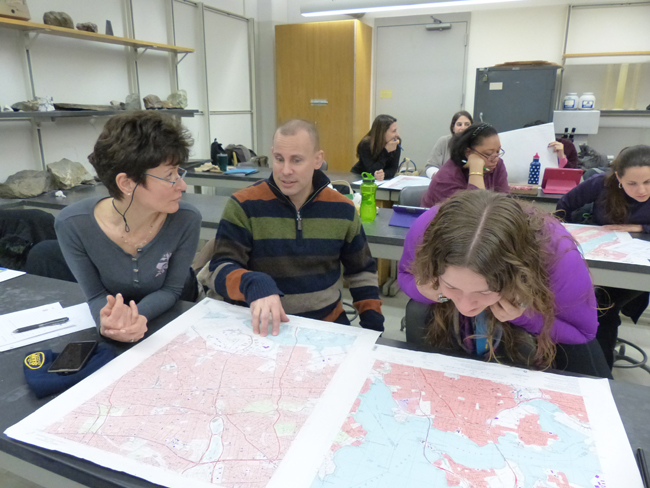
A group of invited elementary school teachers gathered each
day during the first weekend in February 2014 at Queens College to take
part in some "Visualizing Coastal Change" workshops, which are being
funded for a second year through a NOAA Environmental Literacy Grant.
These mostly New York City educators said the mapping exercises were an
extremely effective way of learning the material. Photo: David Jakim
Since
2008, New York Sea Grant and Cornell University's Institute for
Resource Information Sciences Geospatial Program and College of
Agriculture and Life Sciences have been guiding educators—nearly 100 in the first three years alone—in a series of mapping exercises drawn from a Web-based
mapping project on how coastlines change over time along more than 500
miles of New York's urban coastal and estuarine environments.
For
more, see "On YouTube: Geospatial Literacy: Examining Coastal Change Over Time With New York City Teachers"; And for
related resources, see
www.nyseagrant.org/visualizingcoastalchange.
Helping Coastal Communities in NY, NJ and CT Better Prepare for Severe Storms

The National Oceanic and Atmospheric Administration, Sea Grant's federal parent organization, will soon again offer its hurricane season predictions right before Memorial Day Weekend. So, as discussions about severe storms begin to trend again, Sea Grant again offers up its May 2016 short documentary and trailer to help educate emergency managers and empower coastal communities.
The videos are based on a final report from the National Oceanic and Atmospheric Administration's Coastal Storm Awareness Program (CSAP), a $1.8M effort conducted by Sea Grant programs in New Jersey, New York and Connecticut. Through CSAP, a suite of 10 social science studies were funded to help better understand how people respond to coastal storm warnings.
Both the short documentary and accompanying trailer point to resources from NOAA's National Weather Service, the Federal Emergency Management Agency, NYC Office of Emergency Management and more.
More on this at www.nyseagrant.org/csap, where, in addition to news and details on each of the 10 funded projects, you'll find the program's final 286 report that these videos are based on (http://ow.ly/ZTUuw).
Additionally, there is a full-color brochure that serves as a summary of CSAP's social science studies.
NYSG also offers additional resources on severe storms at www.nyseagrant.org/hurricane and www.nyseagrant.org/superstormsandy.
More Info: New York Sea Grant
New York Sea Grant (NYSG), a cooperative program of Cornell University
and the State University of New York, is one of 33 university-based
programs under the National Sea Grant College Program (NSGCP) of the
National Oceanic and Atmospheric Administration (NOAA). The NSGCP
engages this network of the nation’s top universities in conducting
scientific research, education, training and extension projects designed
to foster science-based decisions about the use and conservation of our
aquatic resources. Through its statewide network of integrated
services, NYSG has been promoting coastal vitality, environmental
sustainability, and citizen awareness about the State’s marine and Great
Lakes resources since 1971.
New York Sea Grant maintains Great Lakes offices at SUNY Buffalo, the
Wayne County Cooperative Extension office in Newark and at SUNY Oswego.
In the State's marine waters, NYSG has offices at Stony Brook University
and Stony Brook Manhattan, in the Hudson Valley through Cooperative
Extension in Kingston and at Brooklyn College.
For updates on Sea Grant activities: www.nyseagrant.org has RSS, Facebook, Twitter, and YouTube links. NYSG produces a monthly e-newsletter, "NOAA Sea Grant's Social Media Review," via its blog, www.nyseagrant.org/blog. Our program also offers a free e-list sign up via www.nyseagrant.org/coastlines for its flagship publication, NY Coastlines/Currents, which is published 1-2 times a year.